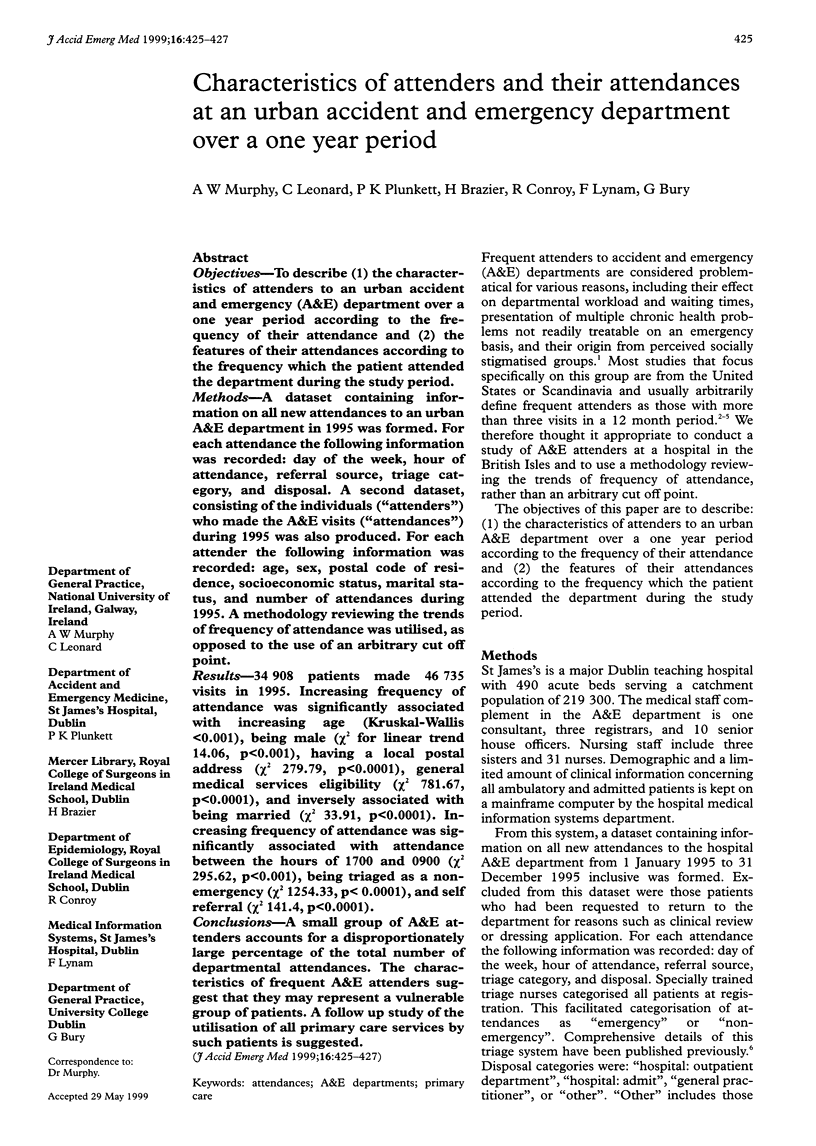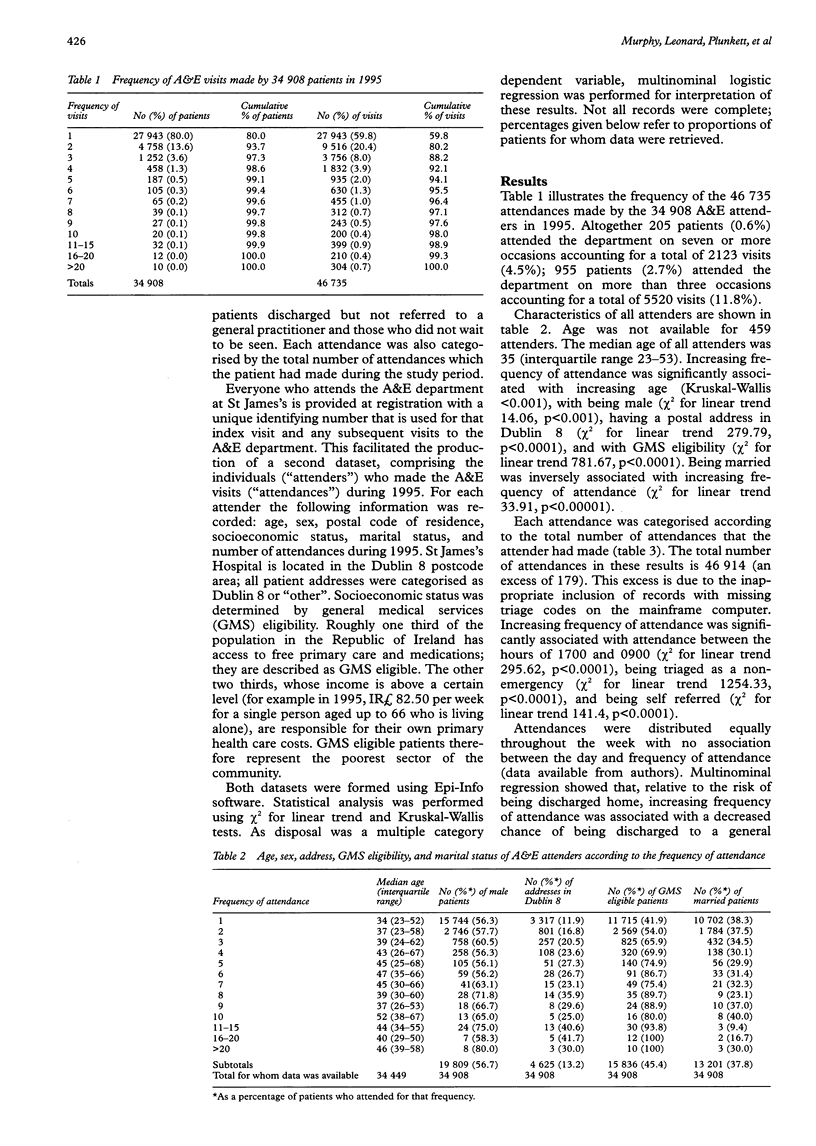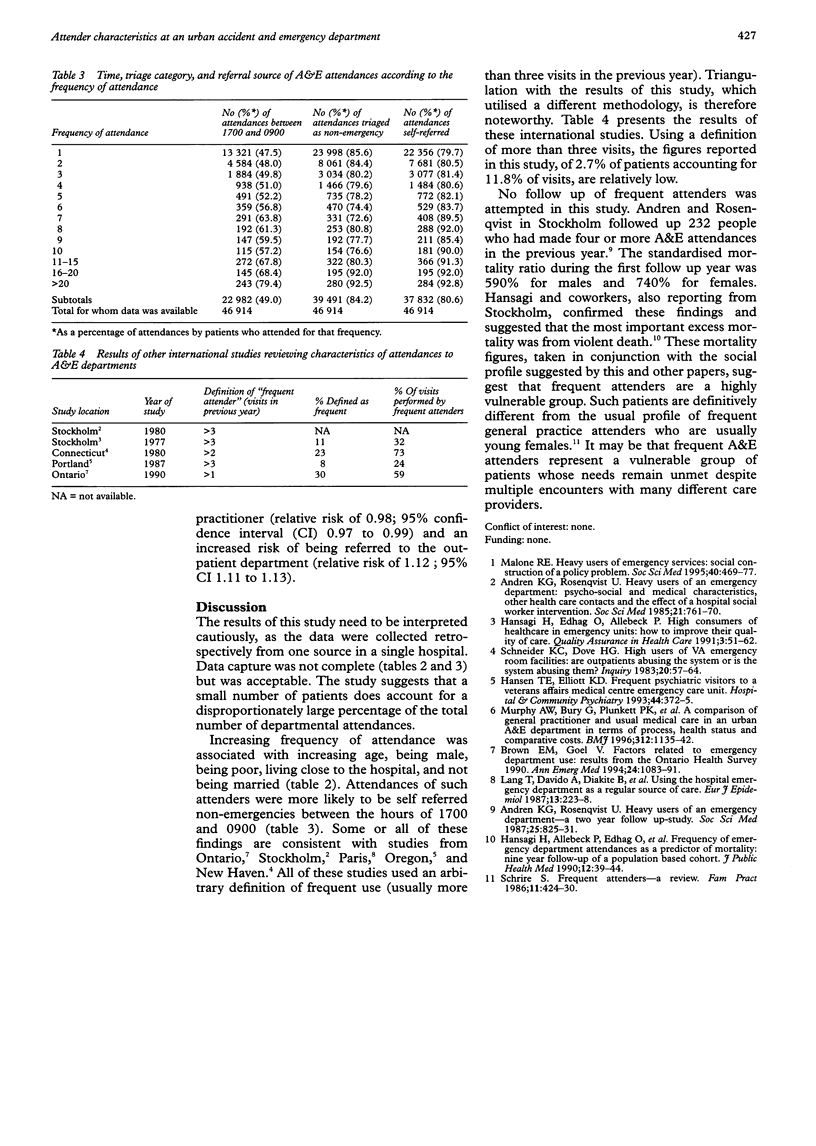Abstract
OBJECTIVES: To describe (1) the characteristics of attenders to an urban accident and emergency (A&E) department over a one year period according to the frequency of their attendance and (2) the features of their attendances according to the frequency which the patient attended the department during the study period. METHODS: A dataset containing information on all new attendances to an urban A&E department in 1995 was formed. For each attendance the following information was recorded: day of the week, hour of attendance, referral source, triage category, and disposal. A second dataset, consisting of the individuals ("attenders") who made the A&E visits ("attendances") during 1995 was also produced. For each attender the following information was recorded: age, sex, postal code of residence, socioeconomic status, marital status, and number of attendances during 1995. A methodology reviewing the trends of frequency of attendance was utilised, as opposed to the use of an arbitrary cut off point. RESULTS: 34,908 patients made 46,735 visits in 1995. Increasing frequency of attendance was significantly associated with increasing age (Kruskal-Wallis < 0.001), being male (chi 2 for linear trend 14.06, p < 0.001), having a local postal address (chi 2 279.79, p < 0.0001), general medical services eligibility (chi 2 781.67, p < 0.0001), and inversely associated with being married (chi 2 33.91, p < 0.0001). Increasing frequency of attendance was significantly associated with attendance between the hours of 1700 and 0900 (chi 2 295.62, p < 0.001), being triaged as a non-emergency (chi 2 1254.33, p < 0.0001), and self referral (chi 2 141.4, p < 0.0001). CONCLUSIONS: A small group of A&E attenders accounts for a disproportionately large percentage of the total number of departmental attendances. The characteristics of frequent A&E attenders suggest that they may represent a vulnerable group of patients. A follow up study of the utilisation of all primary care services by such patients is suggested.
Full text
PDF


Selected References
These references are in PubMed. This may not be the complete list of references from this article.
- Andrén K. G., Rosenqvist U. Heavy users of an emergency department: psycho-social and medical characteristics, other health care contacts and the effect of a hospital social worker intervention. Soc Sci Med. 1985;21(7):761–770. doi: 10.1016/0277-9536(85)90124-8. [DOI] [PubMed] [Google Scholar]
- Brown E. M., Goel V. Factors related to emergency department use: results from the Ontario Health Survey 1990. Ann Emerg Med. 1994 Dec;24(6):1083–1091. doi: 10.1016/s0196-0644(94)70237-3. [DOI] [PubMed] [Google Scholar]
- Genell Andrén K., Rosenqvist U. Heavy users of an emergency department--a two year follow-up study. Soc Sci Med. 1987;25(7):825–831. doi: 10.1016/0277-9536(87)90040-2. [DOI] [PubMed] [Google Scholar]
- Hansagi H., Allebeck P., Edhag O., Magnusson G. Frequency of emergency department attendances as a predictor of mortality: nine-year follow-up of a population-based cohort. J Public Health Med. 1990 Feb;12(1):39–44. doi: 10.1093/oxfordjournals.pubmed.a042504. [DOI] [PubMed] [Google Scholar]
- Hansagi H., Edhag O., Allebeck P. High consumers of health care in emergency units: how to improve their quality of care. Qual Assur Health Care. 1991;3(1):51–62. doi: 10.1093/intqhc/3.1.51. [DOI] [PubMed] [Google Scholar]
- Hansen T. E., Elliott K. D. Frequent psychiatric visitors to a Veterans Affairs medical center emergency care unit. Hosp Community Psychiatry. 1993 Apr;44(4):372–375. doi: 10.1176/ps.44.4.372. [DOI] [PubMed] [Google Scholar]
- Lang T., Davido A., Diakité B., Agay E., Viel J. F., Flicoteaux B. Using the hospital emergency department as a regular source of care. Eur J Epidemiol. 1997 Feb;13(2):223–228. doi: 10.1023/a:1007372800998. [DOI] [PubMed] [Google Scholar]
- Malone R. E. Heavy users of emergency services: social construction of a policy problem. Soc Sci Med. 1995 Feb;40(4):469–477. doi: 10.1016/0277-9536(94)e0116-a. [DOI] [PubMed] [Google Scholar]
- Murphy A. W., Bury G., Plunkett P. K., Gibney D., Smith M., Mullan E., Johnson Z. Randomised controlled trial of general practitioner versus usual medical care in an urban accident and emergency department: process, outcome, and comparative cost. BMJ. 1996 May 4;312(7039):1135–1142. doi: 10.1136/bmj.312.7039.1135. [DOI] [PMC free article] [PubMed] [Google Scholar]
- Schneider K. C., Dove H. G. High users of VA emergency room facilities: are outpatients abusing the system or is the system abusing them? Inquiry. 1983 Spring;20(1):57–64. [PubMed] [Google Scholar]


